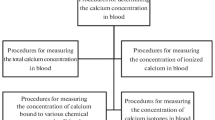Abstract
A robust analytical method for the measurement of 51Cr in blood samples in routine mode by means of liquid scintillation count was developed and validated with spiked blood samples from different subjects. Prior to the measurements, the samples were microwave digested in order to eliminate the matrix influence. Figures of merits, such as sensitivity, limits of detection, precision and accuracy were studied and confirmed the capability of the method to determine 51Cr in blood samples as low as 0.5 Bq g−1 of sample.



Similar content being viewed by others
References
Chechev VP, Kuzmenko NK (2016) Decay Data Evaluation Project (DDEP): updated decay data evaluations for Na-24, Sc-46, Cr-51, Mn-54, Co-57, Fe-59, Y-88, Au-198. Appl Radiat Isot 109:139–145
de Almeida MCM, Iwahara A, Poledna R, da Silva CJ, Delgado JU (2007) Absolute disintegration rate and 320 keV gamma-ray emission probability of Cr-51. Nucl Instrum Methods Phy Res Sect A 580:165–168
Fuglsang S, Henriksen U, Hansen H, Bendtsen F, Henriksen J (2016) Gamma-variate plasma clearance versus urinary plasma clearance of 51 Cr-EDTA in patients with cirrhosis with and without fluid retention. Clin Physiol Funct Imaging. doi:10.1111/cpf.12336
Delgado R, Sanders TM, Bloor CM (1975) Renal blood flow distribution during steady-state exercise and exhaustion in conscious dogs. J Appl Physiol 39:475–478
Vandermeulen E, De Sadeleer C, Piepsz A, Ham HR, Dobbeleir AA, Vermeire ST, Van Hoek IM, Daminet SV, Slegers G, Peremans KY (2010) Determination of optimal sampling times for a two blood sample clearance method using Cr-51-EDTA in cats. J. Feline Med Surg 12:577–583
Shoji M, Kondo T, Honoki H, Nakajima T, Muraguchi A, Saito M (2007) Investigation of monitoring for internal exposure by urine bioassay in a biomedical research facility. Radiat Prot Dosimetry 127:456–460
ICRP Publication 30. Part 2.1980 Limits for Intakes of Radionuclides by Workers Pergamon Press Oxford
Hermanne A, Takacs S, Adam-Rebeles R, Tarkanyi F, Takacs MP (2013) New measurements and evaluation of database for deuteron induced reaction on Ni up to 50 MeV. Nucl Instrum Methods Phys Res Sect B 299:8–23
Moreira DS, Koskinas MF, Yamazaki IM, Dias MS (2010) Determination of Cr-51 and Am-241 X-ray and gamma-ray emission probabilities per decay. Appl Radiat Isot 68:596–599
Solieman AHM, Al-Abyad M, Ditroi F, Saleh ZA (2016) Experimental and theoretical study for the production of Cr-51 using p, d, He-3 and He-4 projectiles on V, Ti and Cr targets. Nucl Instrum Methods Phys Res Sect B 366:19–27
Kikunaga H, Takamiya K, Hirose K, Ohtsuki T (2015) Comparison of the decay constants of Cr-51 with metal, oxide, and chromate chemical states. J Radioanal Nucl Chem 303:1581–1583
Sakita GZ, Meira DC, Bremer Neto H, Cyrino JEP, Abdalla AL (2015) Chromium oxide ((Cr2O3)-Cr-51) used as biological marker was not absorbed by fish. Arquivo Brasileiro De Medicina Veterinaria E Zootecnia 67:755–762
Bobin C, Thiam C, Chauvenet B, Bouchard J (2012) On the stochastic dependence between photomultipliers in the TDCR method. Appl Radiat Isot 70:770–780
Carles AG, Gunther E, Malonda AG (2006) The photoionization-reduced energy in LSC. Appl Radiat Isot 64:43–54
Wanke C, Kossert K, Naehle OJ (2012) Investigations on TDCR measurements with the HIDEX 300 SL using a free parameter model. Appl Radiat Isot 70:2176–2183
Wisser S, Frenzel E, Dittmer M (2006) Innovative procedure for the determination of gross-alpha/gross-beta activities in drinking water. Appl Radiat Isot 64:368–372
Freiser H (1992) Concept calculaton in analytical chemistry. CRS Press, Boca Raton
Acknowledgments
The author would like to thank Dr. Schläger and Dr. Kummerle for the measurements with WBC and γ-spectrometry, respectively, as well as for their valuable discussions. The help of the radioanalytical laboratory staff was also very much appreciated.
Author information
Authors and Affiliations
Corresponding author
Rights and permissions
About this article
Cite this article
Zoriy, M.V., Froning, M. & Hill, P. Development and validation of a robust analytical method for the determination of 51Cr in blood samples by liquid scintillation counting (LSC). J Radioanal Nucl Chem 310, 1299–1302 (2016). https://doi.org/10.1007/s10967-016-4999-7
Received:
Published:
Issue Date:
DOI: https://doi.org/10.1007/s10967-016-4999-7




